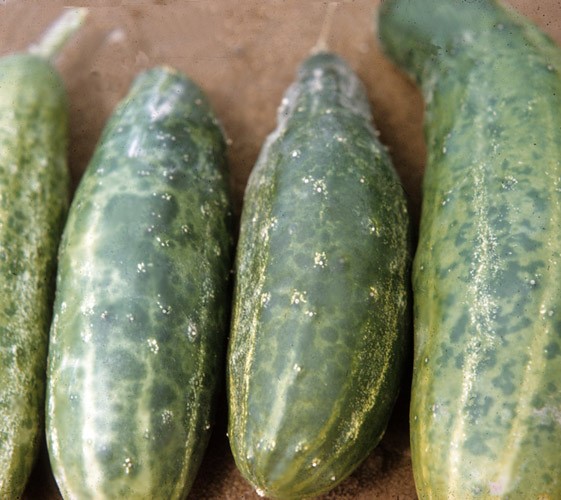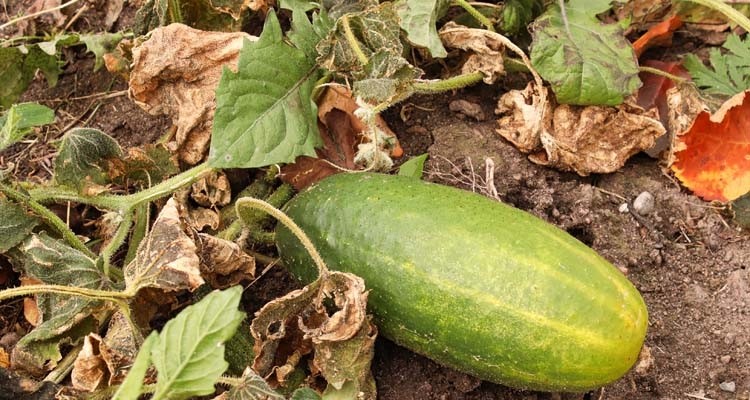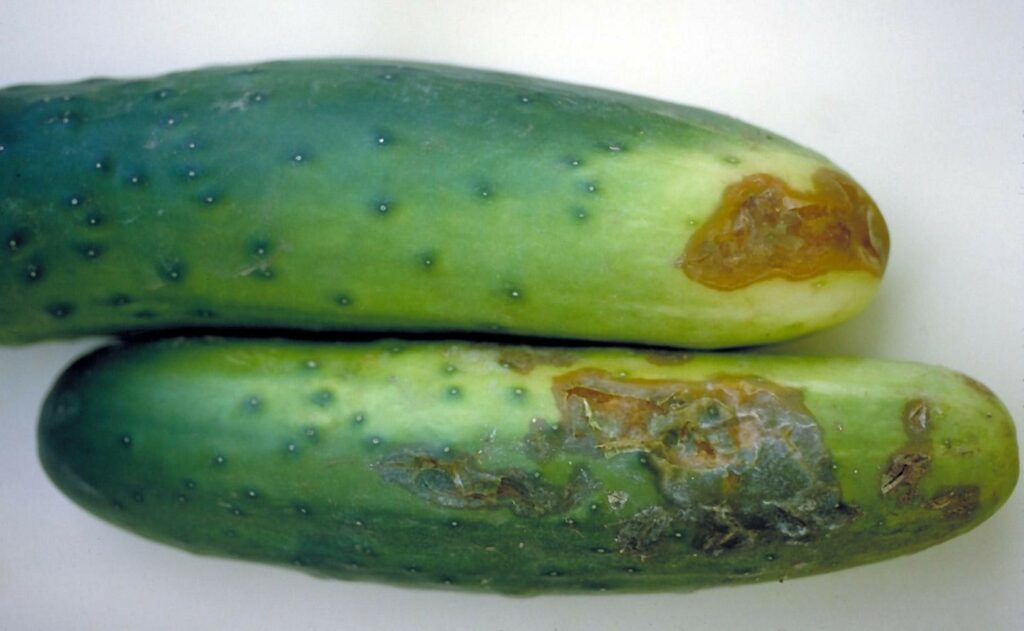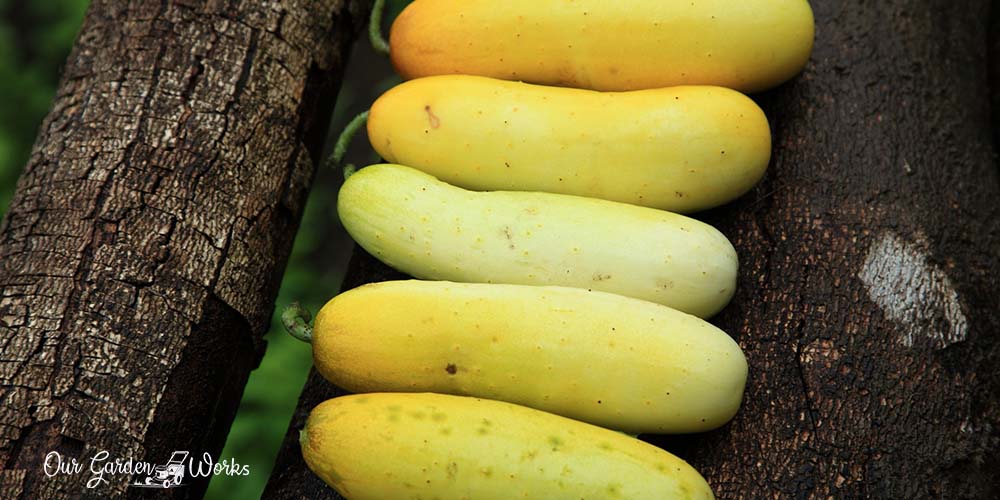From being a crunchy addition to salad to rejuvenating skincare secret, cucumbers are indeed among the best fruit there is. They have a notable green color that often makes other growers think, why are my cucumbers turning yellow? Well, there are a couple of possible reasons.
Cucumbers are well-loved by gardeners because they are easy to grow. As part of the Cucurbit family, they thrive in warm environments and provide high yield.
However, what if the fruits you are expecting to harvest suddenly turn yellow while on the vine?
Read on to learn more.
Q: Why Are My Cucumbers Turning Yellow?
Cucumber fruits often turn yellow because of watering and fertilization issues, fungal disease, and they are yellow from the get-go.
To explain these instances further, we listed the specific causes below:
Yellow Since Birth
Sometimes, fruits are just the way they are and it makes us think they have a problem. Some varieties of cucumbers produce yellow fruits. Since buying seeds or seedlings in a nursery doesn’t give away the fruits that you should expect from a plant, you may overlook the variety.
The yellow cucumber varieties are heirloom types called lemon and Chinese cucumbers. We will discuss the qualities of these fruits later on.
Overripe
Cucumbers are generous givers. Their fruits grow fast and in abundance as long as the weather is warm and they are watered frequently. As they produce a lot of fruits, you must keep on harvesting because they will become overripe, yellow, and bitter.
The yellowing in overripe cucumbers occurs when the plant stops producing chlorophyll or the green pigment just like how pumpkins turn orange when ripe.
Ideally, you can already harvest cucumbers anywhere between 50 to 70 days after planting. Cucumbers that are set for pickling should be harvested when they become 2-8 inches long. It is the stage when they are not yet developing too many seeds.
Overwatered
Cucumbers, either the vine or bush types, have shallow roots. Their ideal watering level is at least one inch per week. However, when the soil is not clogged or contains too much clay, the soil may retain more water, leading to overwatering issues.
If you are wondering what overwatered cucumber looks like, check the image below:
When overwatered, the roots of the cucumber will drown. The nutrient absorption in the soil will be disrupted and cause the cucumber fruits to have a pale yellow color.
Under Fertilized
Cucumbers or cukes are heavy feeders, Old leaves usually give away the signs before the fruits. They have a pale green or yellow color and generally look sickly. Potted cucumber plants need more fertilizer than in-ground ones because the nutrient in the soil is limited. Without adequate feeding, cucumbers will fail to acquire nutrients crucial in producing chlorophyll that can lead to yellow fruits.
Magnesium, potassium, and other micronutrients are the nutrients needed by cucumbers to stay green. Lacking any of these nutrients may also cause stunted growth, lower yield, and plant health deterioration.
To learn about the best fertilizers for cucumbers, you may check them in our separate post here.
Cucumber Mosaic Virus (CMV)

Yellow patches in cucumber fruits can also indicate that the plant is already a host of the cucumber mosaic virus. It is a contagious plant disease that has the widest host range among known plant viruses, giving it other names, such as:
- Banana infectious chlorosis virus
- Coleus mosaic virus
- Cowpea banding mosaic virus
- Cowpea ringspot virus
- Cucumber virus 1
- Lily ringspot virus
- Pea top necrosis virus
- Peanut yellow mosaic virus
- Southern celery mosaic virus
- Soybean stunt virus
- Spinach blight virus
- Tomato fern leaf virus
- Pea western ringspot virus
CMV is widespread across the globe and affects several types of crops. Its distinct symptoms on cucumbers are distorted shape and bumpy fruits, pale and yellowing fruits, stunted growth, and mottling or mosaic-patterned leaves.
The transmission of the CMV is through aphids, infected gardening tools, and even host weed seeds. Sadly, no chemical can manage CMV in plants. The best control is to prevent the virus from spreading to the other nearby crop plants by throwing out the whole plant.
Bacterial Wilt

Cucumbers usually have manageable problems that cause them to turn yellow until they encounter a threatening one like bacterial infections. More than yellowing fruits, bacterial wilt in cucumber can cause rapid wilting of leaves.
Bacterial wilt is a contagious disease transmitted by cucumber beetles. So, when you see one flying around your cucumbers, you must start spraying insecticides before they bring in more problems to your plants like bacterial wilt.
Plants infected with bacterial wilt have no chance of survival, especially if the disease has spread throughout the entire plant.
Anthracnose

Anthracnose is a fungal disease that affects the fruits of cucumbers by causing sunken spots and yellowing patches.
It is a common disease that affects cucurbits like watermelon and pumpkin. The pathogens of this disease are rampant during rainy summers that cause an abundance of humidity around garden beds.
The first sign of the disease is found in the yellow-soaked areas on the stems, leaves, and fruits. When the injury reaches the fruit, the sunken spots become soft, and secondary soft-rotting parasites will feed on it.
The best solution for the prevention of anthracnose is a routine application of fungicide as soon as the vines develop. It is also through preventive care like soil drenching, weeding, and clearing off dead leaves in the ground.
Belly Rot

Another serious disease in cucumbers is belly rot, which causes dry lesions surrounded by yellowish patches on the fruits. It occurs when the fruits and parts of the plant stay too long on the wet soil. When the lesions get worse, they develop a tan-brown color that can progress to more rot.
When the plant and fruits are damaged by belly rot disease, it is best to dispose of the infected plant to protect other crops. The best solution is prevention by keeping vines off and avoiding water splashes on the leaves. Adding a bed of mulch can also help prevent the vines from touching the soil.
Getting To Know Cucumbers
Cucumbers are very rewarding plants to have in a home garden. They provide fresh produce for your salads and tacos during the growing season and give you enough harvest to pickle and preserve for the cold seasons. Learn more about choosing the right variety of cucumbers and how to care for them for high yield.
Types of Cucumbers
Cucumbers are considered annuals in the US. They do not grow back every spring and it dies after reaching a certain amount of days and a slight drop in temperature.
So, during the growing season, farmer favorites like beans, tomatoes, and cucumbers take the spotlight compared to other crops. You can even call them seasonal crops if you may.
Generally, there are two types of cucumbers with three varieties. Sounds confusing?
Let us explain. The two types of cucumber plants are bush-type and vine cucumbers. Then, they are categorized by their fruit quality such as:
- Slicing: fruits intended for fresh consumption.
- Pickling: fruits that are short, stout, thin-skinned, and bred ideally for pickling.
- Seedless/burpless: salad-quality type of cucumbers.
Bush-type cucumbers have short vines and do not need extra support from stakes or trellis. They may be growing 2-feet long vines but they are known to be a generous plant, producing at least a maximum of 20 crunchy fruits per plant. They are an ideal choice for gardeners with small gardens at home.
The most recommended bush cucumbers are as follows:
- Burpless bush hybrid (pickling): Ideal option as a potted crop in small spaces
- Bush crop: A high-yielding dwarf variety with a high yield.
Vine cucumbers, on the other hand, are the most common varieties that spread up to 7 feet. These types of plants grow fast and are best grown on a trellis.
Gardeners often prefer vine cucumbers because the fruits hang from the vines, leaving them clean, easy to pick, and away from soil-borne diseases. The most recommended variety of cucumbers are:
- Boston Pickling: heirloom variety for pickling.
- Lemon: round, yellow, super-sweet fruits. A unique type of cucumber!
- Parisian Pickling: long, thin cucumbers known for making cornichons.
- Sweet Success: produces seedless fruits and does not require pollination.
Disease-resistant varieties
If you want cucumbers that are fail-safe when it comes to fungal diseases, you should consider planting the following cucumber varieties:
- Marketmore 76: resistant to cucumber mosaic virus, powder mildew, and downy mildew.
- Fanfare: resistant to cucumber mosaic virus, powdery mildew, downy mildew, scab, angular leaf spot, and anthracnose.
- Calypso: a vine cucumber ideal for pickling resistant to cucumber mosaic virus and powdery mildew
Tips For Growing Cucumbers
If you want to secure a good harvest of cucumbers here are some tips:
- Keep everything off the soil. You can place a trellis for the vines, or place a bed of mulch to retain moisture in the soil as well as prevent the pathogens of diseases from spreading.
- Do not splash the leaves with water.
- Maintain routine fungicide and insecticide sprays to prevent the spread of cucumber beetles and fungal diseases.
- Before planting the seeds in the soil ensure that the soil is deeply turned to kill the overwintering pathogens in the soil.
- Cucumbers love frequent watering and adequate fertilization when they are developing their vines.
- You also have to harvest the fruits frequently because leaving them in the vines for long will make them bitter and not ideal for consumption.
Frequently Asked Questions (FAQs)
What is the lifespan of a cucumber plant?
Cucumber lives up to 70 days or 2 and ½ months. Once they reached full maturity or experience slight frost, they will start to wilt and die.
What happens if you let a cucumber grow too long?
If you let cucumber fruits stay too long on the vine, they will become overripe, yellow, and bitter. Harvest frequently to ensure that they will be picked at their best flavor and encourage the development of more fruits.
Do cucumber plants need to be replanted every year?
Yes, cucumbers are annual because they die after producing fruits throughout the growing season.
Unlike perennials, they do not hibernate during winter and regrow. Though they require another batch of seeds and plants, cucumbers are among the gardener’s favorites along with other spring and summer crops like tomatoes and peppers.
Can you plant an old cucumber?
You may plant an old store-bought cucumber, however, their likelihood to germinate is low. You should buy quality cucumber seeds to ensure an 80% to 90% germination rate and quality fruits.
Final Thoughts
The next time you ask the question, why are my cucumbers turning yellow, you will remember everything you’ve read in this post. There are simple and serious plant conditions that might cause it. However, by mastering proper plant care for cucumbers, you’ll surely end up with abundant cucumbers for the growing season.
Let us know in the comments about your experience with cucumbers and how did you achieve high-quality yields every time you plant them.
Also, please don’t forget to share this with your friends for better pest and disease management for cucumbers.
